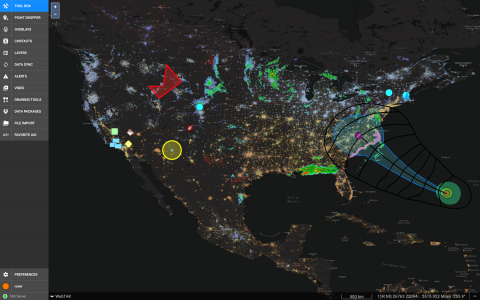U.S. Inauguration’s Military Units Used Draper-developed WebTAK for Communications, Situational Awareness
CAMBRIDGE, MA—At the recent presidential inauguration, public safety was top of mind as thousands of military personnel were posted throughout the U.S. Capitol and the surrounding neighborhoods. Behind the scenes, a new software program developed by Draper called WebTAK gave military units a way to communicate and respond to potential threats in real-time.
The software is based on the Android Tactical Assault Kit (ATAK), which was developed by the Department of Defense and used by Special Operations forces and warfighters. ATAK has been tested through years of real-world use in combat situations, by more than 10,000 active warfighters.
After countless successful military operations, ATAK has grown to a broader product line known as TAK, which is also known as the Tactical Awareness Kit. The software has been deployed on popular technology platforms that include Android OS (ATAK), Microsoft Windows OS (WinTAK) and soon on Apple OS (iTAK). Now, along with contributing to the development of ATAK and WinTAK, Draper has developed a web-based version called WebTAK
At the inauguration, WebTAK was used to share situational awareness and coordinate across multiple agencies. While specifics of the deployment are unavailable for security reasons, the goal of WebTAK is to enhance decision support, situational awareness (SA) and protect military and civilian populations from threats, both intentional and incidental, including chemical, biological, radiological, nuclear and high yield explosives (CBRNE).
Like ATAK, WebTAK is a geospatial collaboration platform that allows teams to share information and access data to improve real-time situation awareness. WebTAK provides a wide variety of useful SA functions including mapping and navigation, range and bearing, text chat, force tracking, geospatial markup tools, image and file sharing and video playback.
“For the first time, operators can access TAK from a password protected and encrypted website on any internet-connected device, instantly,” said Dan Nissen, a software engineer on Draper’s WebTAK team.
As the company’s technical director on WebTAK, Kyle Finley says Draper is not just about creating new technologies, but also ensuring that the full potential of those technologies is realized. “WebTAK’s foundation is a set of core capabilities built using modern web software principles and practices. The recent addition of plugin support to that core opens WebTAK to a whole new world of uses,” Finley said.
WebTAK’s Software Development Kit (SDK) gives developers a framework to quickly develop those custom plugins. These plugins enable rapid integration of innovative technologies into WebTAK, allowing the application to adapt to the continually evolving user needs for situational awareness. In other words, WebTAK was built to be flexible enough so when there is a new “must have” communication device or other technology, anyone with general coding skills can quickly write code enabling the use of that technology within WebTAK.
With WebTAK running on an internet-connected device, a user enters a URL, logs into the system and instantly receives information that can inform situational awareness of an event. The software offers protections through a secure socket layer and end-to-end encryption. As a device-agnostic application, WebTAK is designed to run equally well across various mobile or desktop devices.
“Maintaining continuous situational awareness is the foundation for maintaining security. With WebTAK, warfighters, first responders and public safety officials can customize their operating environment, depending on their role or mission, and benefit from anywhere, anytime secure connectivity through the internet,” explained Brad Vautour, sound designer and senior enterprise software engineer at Draper.
The work is sponsored by the Defense Threat Reduction Agency (DTRA). DTRA is funding development of ATAK, WinTAK, and WebTAK decision support tools, along with supporting leading edge technologies.
Released April 15, 2021

